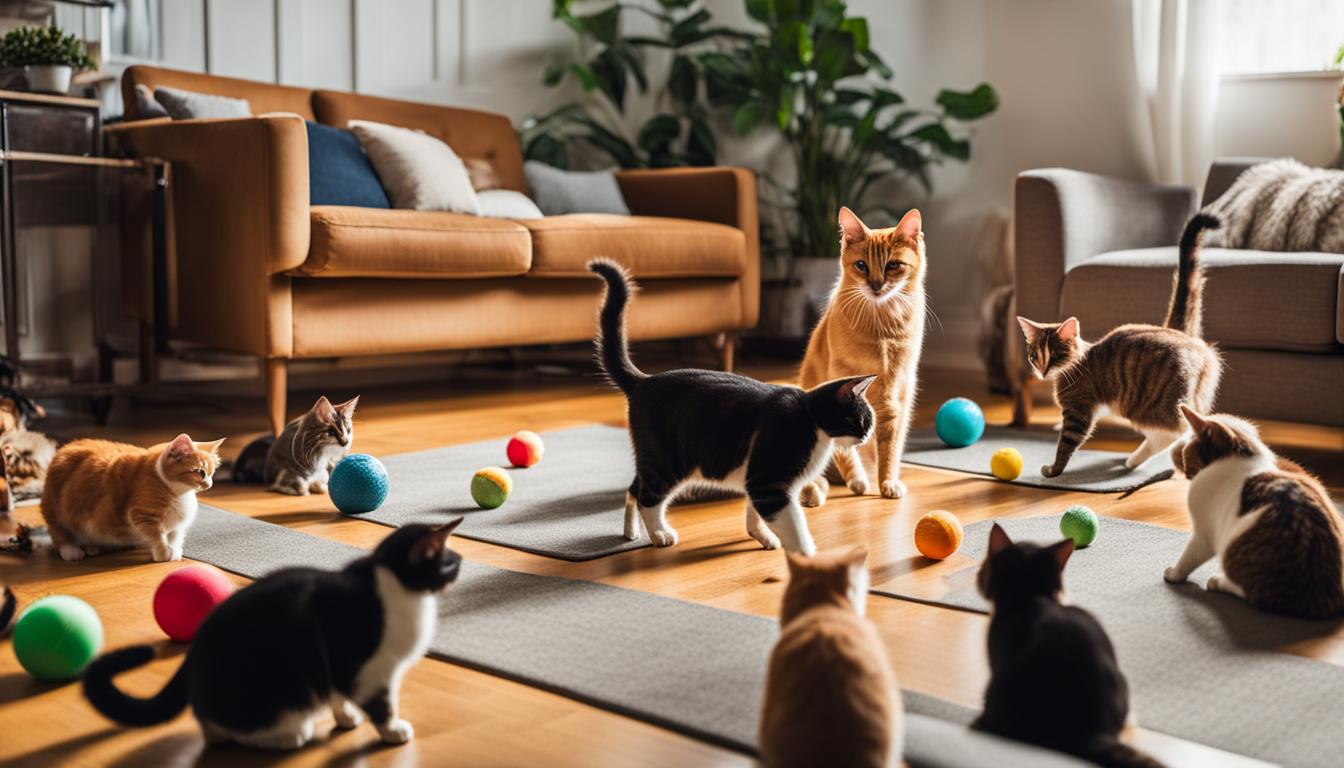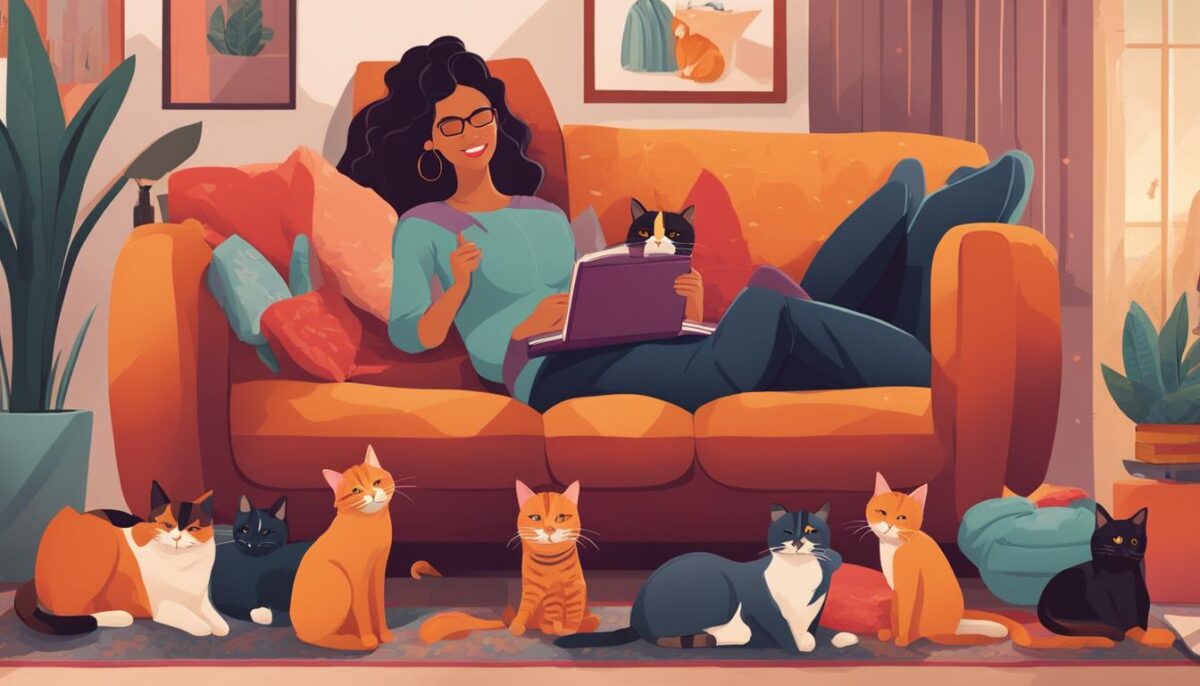If you love cats, you might wonder about the perfect number to have. Is one cat lonely? Are two cats better? Maybe you think about three or more cats for your family. Every home is different. The best number of cats depends on your house, how much time you have, and what you can handle.
Some people might be happy with just two cats. They can play together and keep each other company. But, if you have a big heart and a big home, you might think about more. It’s all about managing multiple cats in a good way. Think about how much space you have and how much love you can give. This will tell you your ideal number of pets.
Remember, each kitty needs care and time. It’s not just about how many cats you want. It’s also about how many cats you can give a good life to. And that’s the most important thing, right?
Key Takeaways
- Think about the size of your home before deciding on your feline family size.
- Having two cats can be nice because they can be friends.
- The more cats you have, the more care they need.
- What’s most important is giving each cat a happy and healthy life.
- Find a number that works for you, with enough time and space for all.
Considering Cat Companionship: Is There a Magic Number?
When thinking about cat companionship, you might wonder if there’s such a thing as the perfect number of furry friends. Some people love a big crowd of kitties, while others prefer just one purring pal. It’s all about finding what makes you and your cats happy!
But how do you know what’s best for you and your whiskered companions? Let’s explore the joys and things to think about in a multi-cat household!
Understanding Feline Friendships and Their Impact on Well-being
Cats often like having a friend or two. They can play tag, snuggle up for naps, and keep each other company when humans are busy. Having more than one cat can mean extra fun and love for everyone.
Assessing Your Personal Capacity for Identifying Your Limit
Think about your day. Do you have enough time to spend with one, two, or maybe three cats? Each kitty deserves attention and care. Also, consider your space. Cats like room to stretch their legs and claim their special spots. And don’t forget about money; each cat means more food, toys, and trips to the vet.
So, what’s the right number for your home? There’s no magic number, but here’s a table to help you think about the balance in a cat-loving home:
| Number of Cats | Playtime & Companionship | Time for Care | Space Needed | Monthly Costs |
|---|---|---|---|---|
| 1 Cat | Single cat needs lots of human playtime. | Plenty for one-on-one attention. | Cozy space just fine. | Less, but focused on quality. |
| 2 Cats | Cats can entertain each other. | Manageable with a good routine. | A bit more room for two. | More, but shared resources like toys. |
| 3+ Cats | Lots of play, might need extra toys. | Need to plan your day well. | Need more spots for naps and play. | Goes up, especially for vet care. |
Remember, determining the optimal cat count is all about finding a happy mix that fits your life and brings joy to your bundle of whiskered friends!
The Human-Feline Bond: Balancing Attention and Care
When you welcome multiple cats into your home, you’re taking on the joyful task of bonding with multiple cats. Each kitty is a tiny friend that needs your love and your time. It’s like every cat holds a little piece of a puzzle. Your job is to put all these pieces together to make one big heart — that’s the human-cat relationship!
Yes, cats like to be boss and do things their way, but they also look to you for cozy cuddles and playtime. As you think about directing attention to pets, imagine you are the conductor of an orchestra. Each cat is a different instrument, and they all need to play in harmony. So, remember to listen closely to their “music” – that means watching how they act and what they’re telling you without meowing a word.
When cats feel loved, they bloom like flowers in the sun. If you can, try to have little moments with each cat. Some may like a gentle pat while others might want to race you to the end of the hall. It’s all about finding what makes each whisker twitch with happiness.
| Cat’s Name | Favorite Game | Favorite Snuggle Spot | Fun Fact |
|---|---|---|---|
| Whiskers | Laser Pointer Chase | Window Sill | Loves belly rubs |
| Mittens | Feather Wand | Under the Bed | Can leap super high |
| Shadow | Box Hopping | Top of the Fridge | Has an extra toe |
See, taking care of one kitty or four is all about love. Cats are pretty smart, and they know when you’re trying your best. If you ever feel like it’s a bit much, take a deep breath, and remember, you’re the most incredible part of their nine lives! Just like you, they need a friend, and they’ve chosen you — that’s pretty pawsome!
Living Space and Quality of Life: How Size Influences Numbers
When you want to make your home cat-friendly, it’s important to think about how much space you have. If you have lots of room, your cats can have a good quality of life. They can run and play without being too close together. But if your place is small, too many cats might feel squished. This can make them unhappy and may cause fights or other troubles.
Good cat owners know that every cat needs their own litter box plus one extra. This helps keep the home clean and the cats happy. Here’s a table that shows you how many litter boxes you should have based on how many kitties you own:
| Number of Cats | Number of Litter Boxes Needed |
|---|---|
| 1 Cat | 2 Litter Boxes |
| 2 Cats | 3 Litter Boxes |
| 3 Cats | 4 Litter Boxes |
| 4 Cats | 5 Litter Boxes |
Having the right amount of space for your feline friends also means you have to think about pet density. This is just a big word to say how many pets you have in the space you live. If you have lots of cats in a small space, it’s like having too many friends over in a small room—everyone feels crowded!
And remember, it’s not just about space to sleep or play. Your cats also need spots to hide when they want to be alone. Plus, having climbing trees or shelves for them to jump on makes your house a better place for cats to live. It keeps them healthy and purring happily!
Financial Responsibilities of a Multi-Cat Household
When you have more than one furry friend at home, it’s important to think about money. Each kitty means more cash spent on things they need. You’ll buy more food, more litter, and take more trips to the vet. And if your cat gets sick, that can really cost a lot. So, having a plan for your money is really smart.
Planning for Pet Expenses: Insurance to Unexpected Emergencies
For your cats to be happy and healthy, you need to be ready for any surprises. Pet insurance can help with big vet bills. But remember, every cat you bring home means your budget needs to grow.
Budgeting for Your Brood: When More Cats Mean More Cost
Think about how many cats you can look after without spending too much. It’s not just about today’s cost for things like toys or treats. You also have to save money for when your cat might need help from the vet.
| Number of Cats | Monthly Food Cost | Litter Cost | Yearly Vet Check-Up | Pet Insurance |
|---|---|---|---|---|
| 1 Cat | $40 | $20 | $100 | $200 |
| 2 Cats | $80 | $40 | $200 | $400 |
| 3 Cats | $120 | $60 | $300 | $600 |
| 4 Cats | $160 | $80 | $400 | $800 |
Cat Health and Hygiene: Preventing Overcrowding Risks
When you have more than one cat, it’s important to make sure they all stay happy and healthy. Too many cats in one place can cause problems. Just like us, cats can feel stressed when they’re not comfortable. We need to watch for signs that cats are not feeling good and help them stay healthy with regular vet visits.
Spotting Stress Signals in Multi-Cat Homes
Stressed cats might hide more or even fight with each other. Other times, they might not use the litter box properly. It’s like when we feel upset and might not want to join in fun games. You can look for these signs so you can help your cats feel better.
The Necessity of Adequate Veterinary Care for Each Cat
Every cat needs to see the vet for check-ups, vaccinations, and to get help if they’re sick. Keeping up with vet visits means each cat gets the care they need. It’s like getting your own check-ups at the doctor to stay super healthy!
| Signs of Stress | What You Can Do | How Vet Care Helps |
|---|---|---|
| Hiding | Create quiet spaces | Check for health issues |
| Fighting with other cats | Give each cat their own toys | Advice on getting along |
| Not using the litter box | Have extra litter boxes | Treat any sickness |
Remember, happy cats make a happy home! By looking for signs of stress and making sure each cat sees the vet, you can keep your fluffy friends feeling their best.
How Many Cats Is Too Many: Setting Your Feline Threshold
Figuring out how many cats are just right for you is all about what makes you comfy and happy. Your life and what you like matter a lot. It’s kinda like deciding on how many scoops of ice cream is perfect – which flavor, how hungry you are, and what your tummy says.
Part of finding your feline threshold is seeing how well you and the cats play together. Do you have enough time to hang out and cuddle with each one? Are you sneezing a lot because of kitty fur? In a multi-cat lifestyle, it’s cool to make sure you and all your cats can have fun and chill without feeling squished for space or time.
Evaluating Personal Comfort Zones and Lifestyle Demands
Your perfect number of cats might be one, two, or more! If you like to take it easy and don’t fancy a big fuss, maybe just a couple of cats would be paw-some. If you’re always on the move and want a whole crew to come home to, you could go for a few more furry friends!
Deciphering Social Dynamics Among Cats
Cats are like us in some ways – they have buddies and sometimes they get a bit grumpy with each other. That’s their cat social structure. When cats get along, they may snuggle up together and chase each other’s tails. But if they start hissing or giving each other the stink-eye, they might need more “me-time.” Watch how they act with each other, and you’ll get the hang of how many cats make a happy home!
So, think about your days, think about your space, and most of all, think about the cozy cuddles. Whether you’re up for having a big cat party or just want a little kitty company, listen to your heart and those purrs – they’ll tell you what’s just right for you!
Behavioral Considerations: Can Too Many Cats Cause Chaos?
Having a lot of cats can be fun, but sometimes it can lead to problems, too. When there are too many cats in one house, they might start to act out because they feel stressed. They might not use the litter box, fight with each other, or lick themselves too much. These are signs of feline behavioral issues that can happen when cats aren’t happy with their space.
If you have a lot of cats, it can be hard to keep an eye on each one. When cats aren’t watched closely, they might get sick and you wouldn’t know until it’s too late. Plus, with too many cats, keeping your home clean can become a big task. No one likes a messy house, right? So, it’s important to watch how your cats behave with each other to make sure they’re all getting along and staying healthy.
Another problem is cat overpopulation. This means having more cats than you can take care of. It’s like having a party with too many guests and not enough snacks for everyone. That can make the cats upset and cause multicat household problems. What you want is a home where all your cats can play, nap, and enjoy life without feeling crowded or ignored. By paying attention to your cats’ actions, you can keep your furry family happy and your home peaceful.
FAQ
What signs indicate that I have too many cats?
Signs might include difficulty managing the cleanliness of your home, cats showing stress-related behaviors such as aggressiveness, urinating outside the litter boxes, or inability to provide adequate attention, care, and veterinary check-ups for each individual cat. If these issues occur, it may be time to reassess your feline family size.
How does the number of cats affect their quality of life?
The number of cats can impact their well-being. Cats need enough space to live, play, and have quiet time away from each other. Overcrowded conditions can lead to stress, behavioral issues, and health problems. Ensuring a cat-friendly living space that meets all your pets’ needs is critical to maintaining their quality of life.
Can having multiple cats benefit their social skills?
Yes, cats can benefit from the company of other felines. They may engage in social behaviors such as playing and grooming each other. This interaction can contribute positively to their overall well-being and help develop their social skills within a multi-cat household.
How do I know if I’m financially capable of caring for multiple cats?
Budget for the everyday costs like food and litter, and factor in the ongoing veterinary care expenses, including regular health check-ups and pet insurance. It’s crucial to mentally prepare for unexpected medical emergencies or special needs for any of your cats. If you can meet these costs without strain, you might be financially stable enough for managing multiple cats.
How many litter boxes should there be in a multi-cat household?
A good rule of thumb is to have one more litter box than the number of cats. So, if you have three cats, aim for four litter boxes. This helps prevent issues with inappropriate elimination and keeps the environment clean and stress-free for your feline companions.
What should I consider when determining how many cats to have in my household?
Consider your living conditions, personal comfort with pet care, time availability, lifestyle demands, and the ability to provide a nurturing environment for each cat. Evaluating these factors will help you identify the ideal number of pets and whether you’re prepared to cope with a multi-cat household.
What are the signs of a good human-cat relationship in a multi-pet household?
A good sign is when you’re able to spend quality time individually with each cat, providing them with affection and the necessary care without feeling overwhelmed. The cats should appear content, exhibiting normal grooming behaviors and good appetite, reflecting a healthy human-feline bond.
How does my living space influence the number of cats I can have?
The size of your living space is directly proportionate to the number of cats you can accommodate comfortably. Cats require enough room to express natural behaviors and have their own space. A cramped environment can lead to increased stress and potential behavior problems among pets.
What behavioral issues might indicate that there are too many cats living together?
Observing your cats for signs of urinating outside the litter box, intercat aggression, and changes in grooming habits, like over-grooming or lack of grooming, can be indicative of too many cats in one space. Monitoring cat interactions can prevent chaos and ensure a peaceful environment.
How important is continuous veterinary care in a household with multiple cats?
Continuous veterinary care is essential. Regular health checks help in early detection of illnesses, proper vaccinations prevent disease spread, and maintaining a regular health record for each cat ensures that all health needs are addressed timely, especially crucial in a multicat household.


